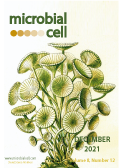Table of contents
Volume 8, Issue 12, pp. 276 - 296, December 2021
Cover: In the 64th plate from Ernst Haeckel's ''Kunstformen der Natur'' (1904), a number of algae are depicted classified as "Siphoneae". Among them is "Acetabularia mediterranea" (no. 10 in plate 64), which belongs to the genus Acetabularia (also known as Mermaid’s Wineglass). This unicellular organism may grow up to 10 cm in height and harbours a single nucleus located at the base of its “stem” (only upon reproduction the nucleus divides). The image retrieved from Wikimedia commons (image modified by MIC). The cover is published under the Creative Commons Attribution (CC BY) license.
Enlarge issue cover
Murals meet microbes: at the crossroads of microbiology and cultural heritage
Maria A. Bauer, Katharina Kainz, Christoph Ruckenstuhl, Frank Madeo and Didac Carmona-Gutierrez
Editorial |
page 276-279 | 10.15698/mic2021.12.765 | Full text | PDF |
Abstract
Our cultural heritage consists of manifold cultural expressions and represents a defining feature of our societies that needs to be further inherited to future generations. Even though humankind always fought a daily struggle for survival, at the same time, it seemed to have a spiritual need that went far beyond mere materialistic satisfaction and nowadays manifests in sometimes very ancient, yet brilliant artistic works. This fundamental legacy is endangered by several instances, including biodeterioration. Indeed, microorganisms play a significant role in the decline of all forms of tangible cultural heritage, including movable, immovable and underwater cultural heritage. Microbial colonization, biofilm formation and damaging metabolite production eventually result in critical decay. Thus, efforts to mitigate the negative impact of damaging microorganisms have been pursued with diverse physical, chemical and biological approaches. Intriguingly, recent advances have unveiled that specific microorganisms and microbial-based technologies also have the potential for cultural heritage preservation and present unique advantages. This short piece provides a quick overview on the duality of microorganisms in the conservation and restoration of cultural heritage.
Forced association of SARS-CoV-2 proteins with the yeast proteome perturb vesicle trafficking
Cinzia Klemm, Henry Wood, Grace Heredge Thomas, Guðjón Ólafsson, Mara Teixeira Torres and Peter H. Thorpe
Research Articles |
page 280-296 | 10.15698/mic2021.12.766 | Full text | PDF |
Abstract
Severe acute respiratory syndrome coronavirus 2 (SARS-CoV-2) is the causative agent of the highly infectious coronavirus disease COVID-19. Extensive research has been performed in recent months to better understand how SARS-CoV-2 infects and manipulates its host to identify potential drug targets and support patient recovery from COVID-19. However, the function of many SARS-CoV-2 proteins remains uncharacterised. Here we used the Synthetic Physical Interactions (SPI) method to recruit SARS-CoV-2 proteins to most of the budding yeast proteome to identify conserved pathways which are affected by SARS-CoV-2 proteins. The set of yeast proteins that result in growth defects when associated with the viral proteins have homologous functions that overlap those identified in studies performed in mammalian cells. Specifically, we were able to show that recruiting the SARS-CoV-2 NSP1 protein to HOPS, a vesicle-docking complex, is sufficient to perturb membrane trafficking in yeast consistent with the hijacking of the endoplasmic-reticulum–Golgi intermediate compartment trafficking pathway during viral infection of mammalian cells. These data demonstrate that the yeast SPI method is a rapid way to identify potential functions of ectopic viral proteins.










